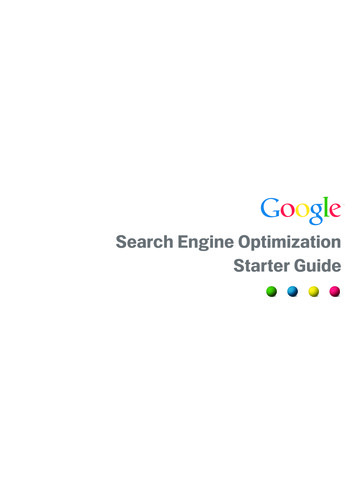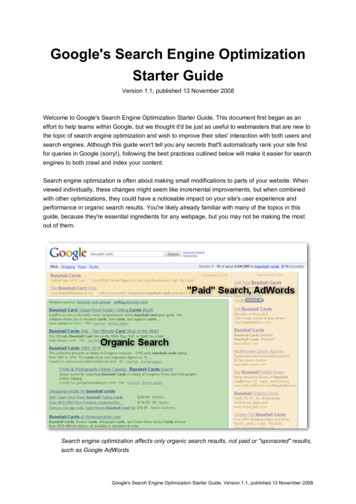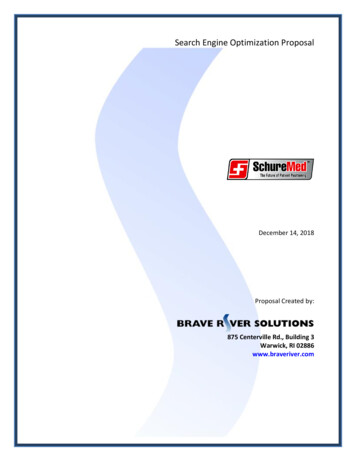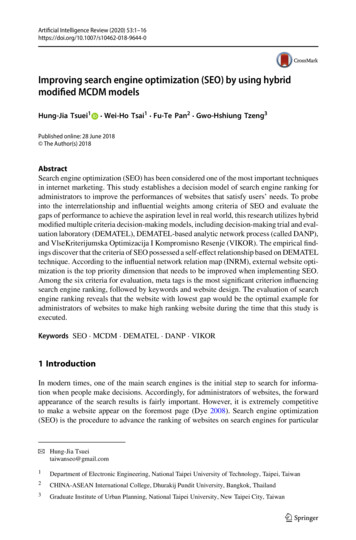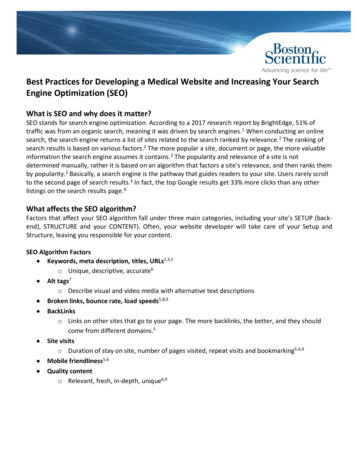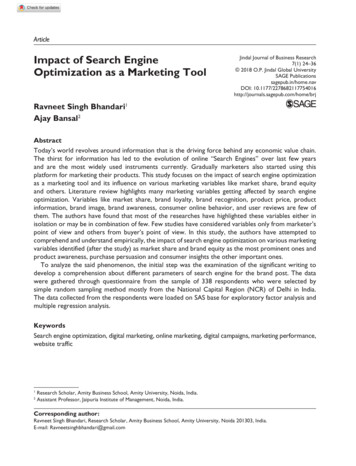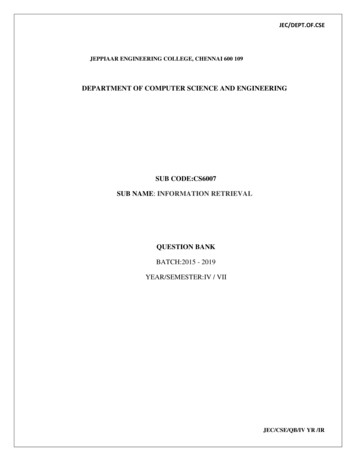
Transcription
Search Engine Optimization: What Drives OrganicTraffic to Retail Sites?M ICHAEL R. B AYEDepartment of Business Economics and Public PolicyKelley School of BusinessIndiana UniversityBloomington IN 47405mbaye@indiana.eduB ABUR D E LOS S ANTOSDepartment of EconomicsClemson UniversityClemson SC 29634babur@clemson.eduM ATTHIJS R. W ILDENBEESTDepartment of Business Economics and Public PolicyKelley School of BusinessIndiana UniversityBloomington IN 47405mwildenb@indiana.eduThe lion’s share of retail traffic through search engines originates from organic (natural) ratherthan sponsored (paid) links. We use a dataset constructed from over 12,000 search terms and2 million users to identify drivers of the organic clicks that the top 759 retailers received from searchengines in August 2012. Our results are potentially important for search engine optimization(SEO). We find that a retailer’s investments in factors such as the quality and brand awarenessof its site increases organic clicks through both a direct and an indirect effect. The direct effectstems purely from consumer behavior: The higher the quality of an online retailer, the greater thenumber of consumers who click its link rather than a competitor in the list of organic results.The indirect effect stems from our finding that search engines tend to place higher quality sites inbetter positions, which results in additional clicks because consumers tend to click links in morefavorable positions. We also find that consumers who are older, wealthier, conduct searches fromwork, use fewer words, or include a brand name product in their search are more likely to click aretailer’s organic link following a product search. Finally, the quality of a retailer’s site appearsto be especially important in attracting organic traffic from individuals with higher incomes. Thebeneficial direct and indirect effects of an online retailer’s brand equity on organic clicks, coupledWe thank the editor and two referees for helpful comments, and Susan Kayser, Joowon Kim, Yoo Jin Lee,and Sarah Zeng for research assistance. We also thank seminar participants at Chapman, the FTC, New YorkUniversity, Mannheim, Northwestern, and the 12th Annual International Industrial Organization Conferencefor helpful comments. Funding for the data and research assistance related to this research was made possibleby a grant from Google to Indiana University. The views expressed in this paper are those of the authors anddo not necessarily reflect the views of Indiana University or Google.This is an open access article under the terms of the Creative Commons Attribution-NonCommercial-NoDerivsLicense, which permits use and distribution in any medium, provided the original work is properly cited, theuse is non-commercial and no modifications or adaptations are made. C 2015 The Authors. Journal of Economics & Management Strategy Published by Wiley Periodicals, Inc.Journal of Economics & Management Strategy, Volume 25, Number 1, Spring 2016, 6–31
7Search Engine Optimizationwith the spillover effects on traffic through other online and traditional channels, leads us toconclude that investments in the quality and brand awareness of a site should be included as partof an SEO strategy.1. IntroductionSearch engines are an important way of obtaining information on the Internet. Accordingto Alexa Traffic Rank, Google.com is the most popular web site in the United Statesas well as in the world, and in May 2011, it was the first web site to achieve onebillion monthly unique visitors.1 Many people use search engines as a starting point fornavigating the Web, making search engines a crucial link in connecting content providersand users. This has spurred a sizable literature on search marketing that studies clickingbehavior at search engines. To date, most of this literature has concentrated on thesponsored links that are typically displayed alongside organic links when consumersconduct searches.Although most of the economics and marketing literature on search engines hasfocused on paid clicks, the bulk of the traffic retailers receive through search enginesis actually through unpaid clicks on organic links (Jerath et al., 2014).2 For this reason,more advertisers engage in search engine optimization (SEO) to improve organic clicksthan purchase sponsored links to get paid clicks (Berman and Katona, 2013). To thebest of our knowledge, the present paper is the first to provide search marketers withinformation on drivers of organic clicks to aid in SEO.Existing studies of sponsored search are typically based on a modest number ofsearch terms and the corresponding number of paid clicks received by a single retailer.Our research complements these studies by focusing on the organic clicks that 759 retailsites received from more than 12,000 search terms. There is considerable cross-sectionalvariation in our data: It includes Web-only retailers as well as traditional retailers andcovers 15 different retail segments including apparel, electronics, and mass merchants.For each of these search terms, we observe which retail sites received organic clicks aswell as the number of clicks. We also obtained data from the first five pages of searchresults on Google and Bing for each search term, and this ultimately permits us toquantify the impact on organic clicks of a site’s rank (position) in the search results.Our data also include several different measures of the accumulated brand equity ofonline retailers. These data allow us to determine whether consumers are more likelyto click the link of a retailer who is perceived to operate a high-quality site (as a resultof the retailer’s current and past investments in advertising, the depth and breadth ofofferings, secure payments, one-click purchases, returns policies, and so on). Ultimately,this permits us to quantify the benefits of SEO strategies that attempt to gain traffic byimproving a retailer’s rank in organic search results, versus gaining traffic by improvingthe quality and brand awareness of a site.Not surprisingly, we find that a retailer’s rank on a results page is an importantdriver of its organic clicks: Exclusion from the first five pages of results for a search leadsto a 90% reduction in organic clicks. For retailers that are listed on the first five pages ofresults, a 1% improvement in rank leads to 1.3% more organic clicks for that search.1. Alexa Traffic Rank is calculated by combining a web site’s average number of daily visitors and pageviews over the past month.2. Our data are consistent with this finding.
8Journal of Economics & Management StrategyImportantly, however, we also find that the brand equity of an online retailer is animportant driver of organic clicks and that it is easy for search marketers to overlook thebenefits of including investments in the quality and brand awareness of its site as part ofan SEO strategy. The direct benefit of these and other investments in brand equity is anincrease in the number of consumers clicking one retailer’s link instead of a competinglink on results pages. Moreover, investments in brand equity have an additional indirecteffect: Search engines tend to place retailers with stronger brands in better positions,which results in additional increases in organic clicks. Finally, estimated effects of rankon organic clicks are keyword specific, whereas improvements in the brand equity of anonline retailer increases clicks associated with all relevant searches. Taking all of theseeffects into account, we find that brand equity is as important as rank in determiningorganic clicks.We also point out that investments that improve site quality and consumer awareness (and more broadly, that enhance an online retailer’s brand equity) are likely to havespillover benefits in other channels that are not accounted for in this or other studies oforganic and sponsored search. These benefits include increases in clicks through otheronline channels (such as price comparison sites), increases in the number of direct visitsto a retailer’s web site, increases in visits through navigational searches at search engines,and increases in traffic at the retailer’s physical stores. These considerations—coupledwith the fact that position is a zero-sum game and thus a retailer is unlikely to obtain asustainable advantage through direct efforts to improve its ranking—lead us to concludethat brand equity is one of the more important components of retailers’ SEO strategies.We also find that a retail site’s brand equity is especially important in attractingorganic traffic from individuals with higher incomes. Our results indicate that consumerswho are older, wealthier, conduct searches from work, use fewer words, or include abrand-name product in their search are more likely to click a retailer’s organic linkfollowing a product search.The remainder of this section provides an overview of SEO and the related literature. Section 2 discusses our data and describes the econometric methodology underlying our analysis. Section 3 presents our empirical findings, whereas Section 4 providesrobustness checks and some additional results. Finally, we conclude in Section 5 withsome additional managerial implications of our findings for SEO.1.1. Search Engine OptimizationFigure 1 highlights the avenues that retailers have for gaining traffic through searchengines. This screenshot shows the search results that appear following a search for“shoes online” using Google Search. In this particular example, three different types oflinks appear: top ads, side ads, and organic results.3 The top ads (marked by the redbox in Figure 1), if any, are the highest listed search results and appear against a yellowbackground. For this particular search there are three top ads; the maximum number oftop ads that may be displayed is four. The organic results (marked by the blue box) arelisted below the top ads. Up to ten organic results can appear on a search result page.Finally, the side ads (purple box) appear on the right-hand side of the screen; Googleallows for up to eight side ads to be shown on a result page.3. Depending on the search term, up to four bottom ads may appear as well. For the search term “shoesonline” no bottom ads were shown.
9Search Engine OptimizationFIGURE 1. SEARCH RESULTSOne way retailers obtain traffic is through the paid links that appear in top or sideads. Unlike organic links, retailers can directly influence the position of ads, which aredisplayed and ranked according to the results of an auction that is run in real time.Retailers identify keywords they want to bid on and specify how much they are willingto spend. Google determines the ad rank using a site’s maximum bid specified forthe keyword and a quality score, which includes factors like click-through rates andrelevance. Advertisers only pay when the link is clicked; the cost per click is equal to theminimum amount needed to get a specific position (generalized second-price auctionmechanism). There is an extensive literature (discussed below) examining this avenuefor obtaining clicks.A second way retailers obtain traffic through the search engine channel is throughclicks on organic results, and this is the focus of our analysis.4 A site’s position in Google’sorganic search results depends on the site’s relevance to a given search term. The exact4. Although our main focus is on organic (non-paid) links, we do take the presence of sponsored links(ads) into account, because they may affect organic clicking behavior.
10Journal of Economics & Management Strategyalgorithm that Google uses to determine a site’s ranking is proprietary; according toGoogle, it depends on thousands of factors.5Although the goal of SEO is to optimize the organic traffic a retailer receives throughproduct searches on search engines, the ultimate goal of retailers is presumably tomaximize their profits. One of the initial steps in this optimization process is identifyingthe benefits and costs of different strategies for increasing traffic.6 Our paper representsa first attempt to examine the benefits side of the ledger, and in particular, to quantifythe drivers of retailers’ organic clicks.The first, and most common, SEO strategy is to tweak a site in an attempt toincrease the rank of a retailer’s organic link on the results pages for a given search term.The presumption is that higher ranks result in more organic clicks, but SEO requiresquantifying the effects of rank on clicks. This is one objective of our paper.One myopic tactic for improving position, known as a “black-hat” strategy, isdesigned to “trick” search engines into elevating a retailer’s rank in the results. Searchengines are themselves players, and have incentives to adapt algorithms to ensure thatsearch engine users receive relevant results. Consumers are players too, and may favorlinks of retailers they know and trust: SEO strategies that focus exclusively on rank(such as spamming links or hiding keywords) might improve the position of a retailer’slink but not impact its clicks. For this reason, SEO strategies based on “tricking” or“spamming” engines are unlikely to yield sustainable improvements in rankings, maynot result in additional clicks, and can even backfire as a result of negative effects onreputation. Furthermore, it is important to recognize that rankings are effectively a zerosum game: One retailer can move up on a particular results page only by pushing downthe link of another retailer. Thus, although it makes sense for online retailers to ensurethat their sites include page titles that accurately describe content, make use of headtags, are free of dead links, and so on, these efforts alone are unlikely to give a particularretailer a sustainable rank advantage because other retailers have incentives to engagein these strategies as well.A second and more costly SEO strategy—but one that is more likely to yieldsustainable improvements in a retailer’s organic traffic from search engines—focuses onimproving site quality and brand awareness, or more broadly on enhancing the onlineretailer’s brand equity (which embodies current and past investments in advertising,service and return policies, depth and breadth of offerings, prices, etc.). This strategyrecognizes that consumers tend to click retailers that are more recognized, trusted, havereputations for providing value (in terms of prices, product depth or breadth), service(well-designed web sites, return policies, secure payment systems), and so on. ThisSEO strategy is alluded to by Google, which advises businesses to base “.optimizationdecisions first and foremost on what’s best for the visitors of your site. They’re the mainconsumers of your content and are using search engines to find your work. Focusingtoo hard on specific tweaks to gain ranking in the organic results of search engines maynot deliver the desired results.” 7Although it may be tempting to dichotomize rank-improving and brand-buildingSEO strategies, these two strategies are not mutually exclusive. Indeed, brand-building5. See http://www.google.com/explanation.html. One of these factors is Google PageRank, which is analgorithm that uses the number of incoming links to measure the relative importance of a web site.6. SEO is based on the premise that more clicks translates into more sales, thus making organic clicks auseful intermediate metric.7. See Google’s Search Engine Optimization Starter Guide, 2013, p. 2. A link to this guide is available onlineat ?hl en&answer 35291
Search Engine Optimization11activities may indirectly result in better positions. Furthermore, unlike direct investments in position, brand-building investments are not a perfect zero-sum game becauseconsumers always have an option not to click on any organic search results. For example, some consumers using the search phrase “tennis shoes” might not recognize anyretailers in the list of search results, and hence not click on any links. If these retailersall invest in the brand awareness of their sites, they each may receive additional clicksbecause consumers are less likely to exercise the outside option.1.2. Related LiteratureOur paper is connected to several different literatures, including a handful of academicpapers on SEO which provide important theoretical insights into SEO (Sen, 2005; Xingand Lin, 2006; Berman and Katona, 2013). These papers highlight several features of theequilibrium interaction between web sites and search engines that we take into accountin our empirical analysis, including the endogeneity of the rank of organic links and theposition of sponsored links in search results. To the best of our knowledge, there is noantecedent empirical research on SEO.There is, however, a sizeable theoretical and empirical literature on search enginesthat focuses on the sponsored links that appear alongside the organic results. The theoretical literature has in particular focused on the auction mechanism behind these paidresults (e.g., Edelman et al., 2007; Varian, 2007). Earlier studies took user behavior asgiven; more recent work by Chen and He (2011) as well as Athey and Ellison (2012)take into account that users search optimally. White (2013) and Xu et al. (2012) focus ontrade-offs between organic and sponsored search results.The empirical research on search engines has mostly focused on sponsored searchas well. Yao and Mela (2011) develop a dynamic structural model of keyword advertisingthat takes optimal consumer behavior into account. Animesh et al. (2010) focus on qualityuncertainty in sponsored search markets and find some evidence of adverse selection,but only for unregulated sponsored search markets. Ghose and Yang (2009) focus onad placement and its effects on profitability and find a negative relationship betweenposition and click-through rate as well as conversion rates. Agarwal et al. (2011) alsofind a negative relationship between position and click-through rates but find a positiverelationship with conversion rates, which means that the top position is not necessarilythe most profitable.8Our paper is also related to three recent papers that focus on the relationshipbetween sponsored and organic search results. Yang and Ghose (2010) find organic clicksto be positively related to the presence of sponsored links, and vice versa. However, thepresence of an organic link increases the utility of a sponsored listing more than the otherway around. Similarly, Agarwal et al. (2015) find the presence of a link in the organicsearch results to be positively related to the click-through rate for sponsored links, butnegatively related to conversions. A third paper by Jerath et al. (2014) uses clicks databased on 120 keywords to examine how the “popularity” of different keywords impactsclicking behavior. Their results suggest that less popular keywords are “more targetable”for sponsored search advertising than more popular keywords.8. Other contributions to the literature on sponsored search include Jeziorski and Segal (2015) and Blakeet al. (2015), among others.
12Journal of Economics & Management StrategyFinally, our research is related to a very large literature documenting the importance of screen position and a seller’s reputation or brand equity 9 for retailers sellingthrough other online channels including price comparison sites, shopbots, and auctionsites (Brynjolfsson and Smith, 2000; Melnik and Alm, 2002; Dellarocas, 2003; Baye andMorgan, 2009; Baye et al., 2009; De los Santos et al., 2012). Although the broad messageis that branding, screen position, consumer attributes, and retailer characteristics areall important determinants of click-through behavior in these channels, to date, little isknown about their impact on organic clicks through search engines.2. Data Description and Econometric Model2.1. Data DescriptionOur main dataset is assembled using data from comScore Search Planner and containsinformation on the number of organic clicks web sites received for search terms andphrases entered at main search engines (i.e., Google, Bing, Yahoo, AOL, and ASK)during August 2012. Search Planner uses the comScore panel, which contains all onlinebrowsing activity of around two million U.S. users. Because our goal is to analyze thedrivers of organic traffic following product searches, we restrict our sample to onlyinclude web sites that are Internet retailers. For this we make use of Internet Retailer’sTop 500 Guide, which contains a ranking of North America’s 500 largest e-retailersbased on annual Web sales. Although not all of these retailers appeared in the comScoreSearch Planner database, some e-retailers (e.g., Amazon) operate multiple web sites(e.g., Amazon.com and Zappos.com), resulting in a total of 759 retail sites for whichwe have click-through data. For each of these 759 retailers, we used Search Planner toidentify all search terms that generated traffic from Google to the retailer. There is someoverlap in search terms: as shown in Figure 1, Onlineshoes.com as well as Zappos.comappear relatively high in the organic results for the term “shoes online,” which meansthat for both retailers this term is part of the set of search terms that generated trafficfrom Google. In total we end up with 12,184 distinct search terms that led users to the759 online retailers. The third dataset we use contains all the links that appeared on thefirst five search results pages on Google Search and Bing Search for each of the 12,184search phrases. We collected these data using a scraper written in Java; the data containorganic search results as well as paid links.10Not all 759 online retailers are relevant for each of the search terms in our data.For instance, Best Buy is not relevant for individuals searching for shoes and is therefore9. Aaker (1991) defines brand equity as “a set of brand assets and liabilities linked to a brand, its nameand symbol, that add to or subtract from the value provided by a product or service to a firm and/or to thatfirm’s customers.” Brand equity is based on factors like brand loyalty, name awareness, and quality. See Kellerand Lehmann (2006) for a recent survey of the branding literature.10. Given the time required to query Bing and Google with the 12,184 search terms, our Java programretrieved position results only once. Given the intervening time between clicks and the collection of rank data,two potential issues arise: (a) endogeneity of position, which we address in Section 2.2, and (b) the stability ofranks over time. The limited data we have suggest that ranks for product searches are likely to be fairly stableover the relatively short window of time that is at issue here. For example, an examination of rank data wecollected for two different projects reveals that, for the 3,599 overlapping observations in these two datasets,the (pooled) correlation between each firm’s rank for searches conducted in July 2012 with its rank for thesearches conducted in September 2012 is 0.80. Although we do not have more frequent (e.g., daily or weekly)data on ranks, the relatively high correlation in ranks over this 2-month period suggests that ranks are likelyto be reasonably stable within the span of a single month.
Search Engine Optimization13unlikely to show up in the search results for “shoes online.” 11 Given that a retail sitemust be listed on the search results pages to receive organic clicks, we only include aretailer as an observation for a specific search term if we observe the retail site in oursearch results data. Because we only captured the first five pages of search results, thisdoes not rule out that a site that did not appear in these search results did in fact getclicks; we therefore also include a retail site if the site received organic clicks for thesearch term according to the Search Planner database.Our measure of a retail site’s brand equity is based on the methodology developed in Baye et al. (2012) to overcome challenges in measuring the “prominence” ofonline retailers’ names. These authors point out that the standard approach, which useshistorical advertising data to measure accumulated brand equity and the strength ofa firm’s name, is not useful in the case of online retailers. Among other things, manyonline retailers are privately held and do not disclose advertising expenditures; theparent companies of publically traded online retailers do not typically report monthlyadvertising expenditures at the URL level. They further argue that the number of product searches on Google (or Bing) that include the retailer’s name or URL in the searchquery—navigational searches, in industry parlance—is a useful measure of a retailer’sbrand equity. Intuitively, the inclusion of “Amazon” in a product search indicates theconsumer recognizes the company and can recall its name. This may be the result ofpast advertising campaigns, recommendations from friends, knowledge of Amazon’spricing practices, product depth, return policies, and so on. And in contrast to advertising expenditures, it is possible to use data from comScore to measure the number ofnavigational searches Amazon received in a given month.Based on a revealed preference argument, Baye et al. conclude that the number ofnavigational searches for a retailer in a given month embodies more than name recognition or recall; the inclusion of a retailer’s name in a product search indicates that theconsumer values the attributes associated with its name (e.g., its reputation, productbreadth, product depth, and service quality), and that search results with links to thatparticular retailer are desirable. Baye et al. provide evidence that this measure workswell in both retail and education contexts.12 For example, they show that there is astrong relationship between navigational searches for universities and external rankings of their quality: Universities with stronger brand names (e.g., Harvard University)receive significantly more navigational searches than universities with weaker brandnames (e.g., Indiana University). Moreover, they provide evidence that the prestige of auniversity—not its size—is the main driver of the navigational searches it receives.For these reasons, we use navigational searches to measure a firm’s brand equity.Navigational searches are essentially a shortcut for typing in the URL of a specific retailerand then searching its site. Thus, our measure of brand equity is the total number oforganic clicks a particular retailer received in August 2012 from searchers who navigated11. Indeed, Best Buy did not show up in at least the first 30 pages of search results on Google for the searchterm “shoes online” (checked on February 26, 2013).12. Although many of the general branding principles carry over to retailers, the measurement of retailbrand equity provides some unique challenges; Ailawadi and Keller (2004) identify some unique issues to themeasurement of retail brand equity. For our purposes, the key is that this measure is related to the overallimage of an online retailer and its attributes, which includes factors like name recognition, product breadthand depth, shopping experience, and reputation (prices, quality, shipping, return policy, etc.).
14Journal of Economics & Management Strategyto its site by including the retailer’s name as a search term, including misspellings;examples include “Amazon,” ”Amazn,” and “Buy camera at Amazon.”13Although we use navigational searches to construct our measure of brand equity,our dependent variable excludes organic clicks from navigational searches. We seek tounderstand why searchers choose to click on Amazon (or some other link) following anon-navigational search like “Levis Jeans,” and not why they click on an Amazon linkfollowing a navigational search like “Amazon.” Thus, in our econometric analysis oforganic clicks, we exclude all search terms (and hence organic clicks based on searches)containing the name of one of the 759 retail sites. This results in 40,117 observations,where each observation is the number of clicks for each search term-retailer.In addition to the number of organic clicks per retail site, the Search Planner dataalso contain information on the demographics of searchers using each of the search terms,including the percentage of searchers by age, income, and location (home or work). Wealso used data from Internet Retailer’s Top 500 Guide to identify each retailer’s retailsegment (e.g., mass merchant, apparel and accessories, sporting goods, etc.), whether theretailer has a presence on social media (Facebook or Twitter), the year in which the retailsite began operating online, and whether the retailer has a brick-and-mortar presence.Table I provides summary statistics of these variables, as well as the other variables weuse in our analysis.Finally, we analyzed each search term and constructed search-term specific variables based on the content of the search term. The first variable is the number of wordsin the search term. The second variable, denoted branded search term, is an indicatorvariable for whether the search terms include the brand name of a product (e.g., Nike orAdidas) in the product search. Note that, in our sample, this is different from the brandassociated with a particular retailer’s site (e.g., Zappos or Amazon). These two searchterm specific variables may tell us something about the intent of search. For instance, anindividual searching for “Nike running shoes” is more specific in what she is lookingfor than someone searching for “shoes online,” and this may affect clicking behavior.2.2. Econometric ModelOur main objective is to study the drivers of organic clicks arising from searches forproducts on search engines.14 Let Clicksik denote the total number of organic clicksretailer i received from individuals searching for search term k. Because of the presenceof substantial positive skewness in organic clicks data, we use
Search Engine Optimization 9 FIGURE 1. SEARCH RESULTS One way retailers obtain traffic is through the paid links that appear in top or side ads. Unlike organic links, retailers can directly influence the position of ads, which are displayed and ranked accordi
